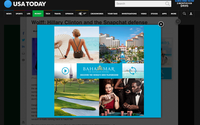As a publishing industry, are we any better at selling online ads now than when we first started? How could we be, if we never got the publishing formula right to begin with?
For a
publishing business to work, you have to nurture and grow loyal consumer attention. This is the backbone for publishing success. Growth in loyal attention occurs when consumer interests
sit firmly above advertiser “requirement” demands. When this order is reversed, incentives become misaligned. That has been our problem since the beginning.
Instead of
focusing on nurturing the user relationship above all else, the industry focused on ad-buying automation. Our tech advancements are to be celebrated -- but the downside of a self-serve
advertising platform with incentive alignment issues is a system that rewards bad publishing behavior with greater ad dollars.
Here are two examples of publishers making money while trampling
the user experience -- and one example that at 20 years old, we still have so much growing up to do.
advertisement
advertisement
1. International Business Times. InternationalBusinessTimes.com is a site
Yahoo, an industry leader, promotes on its home page for me every day. An executive at IBT recently shared, “Our strategy is to push programmatic as far as we can.” This
executive also shared, “We have a huge team of editors and writers to create a very good product, and we care about usability.”
I rail on programmatic -- and here's a
perfect example of why.
 Programmatic allows sites
like IBT to make money selling ads. Here’s what misaligned incentives look like on a site that “cares about usability”: (See image at left.)
Programmatic allows sites
like IBT to make money selling ads. Here’s what misaligned incentives look like on a site that “cares about usability”: (See image at left.)2. We’re
still selling pop-ups. We call them different names, but these ads still pop up and over the content a user is looking to read. Is there anything that says, “I care more about an ad
dollar than the user experience” than these ads? Have you ever seen a pop-up ad while visiting an advertiser’s site? (See image below, right).
3. We
chase headlines while losing credibility. We still say shit that sounds great to a reporter (like the quote from the IBT executive about the user experience) or in front of large conference
audiences, but when you dig deeper to what is said, we raise more eyebrows and lose more credibility.

One of our industry’s tallest celebrities is Tim
Armstrong. When the CEO of AOL talks, he commands a room like no one else. He has always been that charismatic (we worked together in 1999 at Snowball.com, and teamed up to close a
million-dollar ad deal).
Last week Tim spoke at the 4A’s conference, where he called out television advertising as being wasteful. He referred to a Buick ad he
had seen way too many times while watching the NCAA tournament. To a room full of advertising agency professionals, he implied that these impressions -- and hence dollars -- were wasted because
of their frequency and lack of targeting.
If anyone in that room had visited AOL that day, they might have seen what I did, which was the same exact Verizon ad on nine consecutive page
views. Not only was the frequency an issue, I had signed up for Time Warner Cable phone service the week before, so all of these impressions were truly wasted. Tim knows his own site and
yet he had no problem calling the kettle black because it made for great headlines.
Oh, and after the ninth page view, I found an article about coffee I was interested in. When I clicked to
read more, I was met with this fantastic ad below:

1999 called and they want their ads back. Can we please return them and start this thing all over? Web site users despise us -- and that’s just not how
publishing is supposed to work.